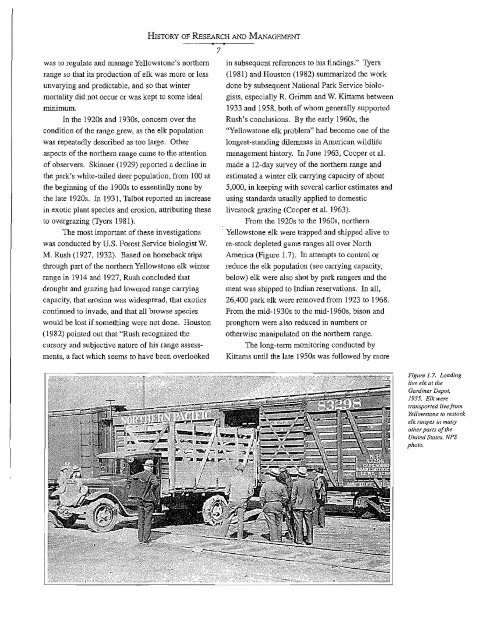Yellowstone's Northern Range - Greater Yellowstone Science ...
Yellowstone's Northern Range - Greater Yellowstone Science ...
Yellowstone's Northern Range - Greater Yellowstone Science ...
Create successful ePaper yourself
Turn your PDF publications into a flip-book with our unique Google optimized e-Paper software.
HISTORY OF RESEARCH AND MANAGEMENT<br />
was to regulate and manage <strong><strong>Yellowstone</strong>'s</strong> northern<br />
range so that its production of elk was more or less<br />
unvarying and predictable, and so that winter<br />
mortality did not occur or was kept to some ideal<br />
minimum.<br />
In the 1920s and 1930s, coucern over the<br />
condition of the range grew, as the elk population<br />
was repeatedly described as too large. Other<br />
aspects of the northern range came to the attention<br />
of observers. Skinner (1929) reported a decline in<br />
the park's white-tailed deer population, from 100 at<br />
the beginning of the 1900s to essentially none by<br />
the late 1920s. In 1931, Talbot reported an increase<br />
in exotic plant species and erosion, attributing these<br />
to overgrazing (Tyers 1981).<br />
The most important of these investigations<br />
was conducted by U.S. Forest Service biologist W.<br />
M. Rush (1927, 1932). Based on horseback trips<br />
through part of the northern <strong>Yellowstone</strong> elk winter<br />
range in 1914 and 1927, Rush concluded that<br />
drought and grazing had lowered range carrying<br />
capacity, that erosion was widespread, that exotics<br />
continued to invade, and that all browse species<br />
would be lost if something were not done. Houston<br />
(1982) pointed out that "Rush recognized the<br />
cursory and subjective nahlre of his range assessments,<br />
a fact which seems to have been overlooked<br />
7<br />
in subsequent references to his findings." Tyers<br />
(1981) and Houston (1982) summarized the work<br />
done by subsequent National Park Service biologists,<br />
especially R. Grimm and W. Kittams between<br />
1933 and 1958, both of whom generally supported<br />
Rush's conclusions. By the early 1960s, the<br />
"<strong>Yellowstone</strong> elk problem" had become one of the<br />
longest-standing dilemmas in American wildlife<br />
management history. In June 1963, Cooper et al.<br />
made a 12-day survey of the northern range and<br />
estimated a winter elk carrying capacity of about<br />
5,000, in keeping with several earlier estimates and<br />
using standards usually applied to domestic<br />
livestock grazing (Cooper et al. 1963).<br />
From the 1920s to the 1960s, northern<br />
<strong>Yellowstone</strong> elk were trapped and shipped alive to<br />
re-stock depleted game ranges all over North<br />
America (Figure 1.7). In attempts to control or<br />
reduce the elk population (see carrying capacity,<br />
below) elk were also shot by park rangers and the<br />
meat was shipped to Indian reservations. In all,<br />
26,400 park elk were removed from 1923 to 1968.<br />
From the mid-1930s to the mid-1960s, bison and<br />
pronghorn were also reduced in numbers or<br />
otherwise manipulated on the northern range.<br />
The long-term monitoring conducted by<br />
Kittams until the late 1950s was followed by more<br />
Figure 1.7. Loading<br />
live elk at the<br />
Gardiner Depot,<br />
1935. Elk were<br />
transported live from<br />
<strong>Yellowstone</strong> to restock<br />
elk ranges in many<br />
other parts of the<br />
United States. NPS<br />
photo.















